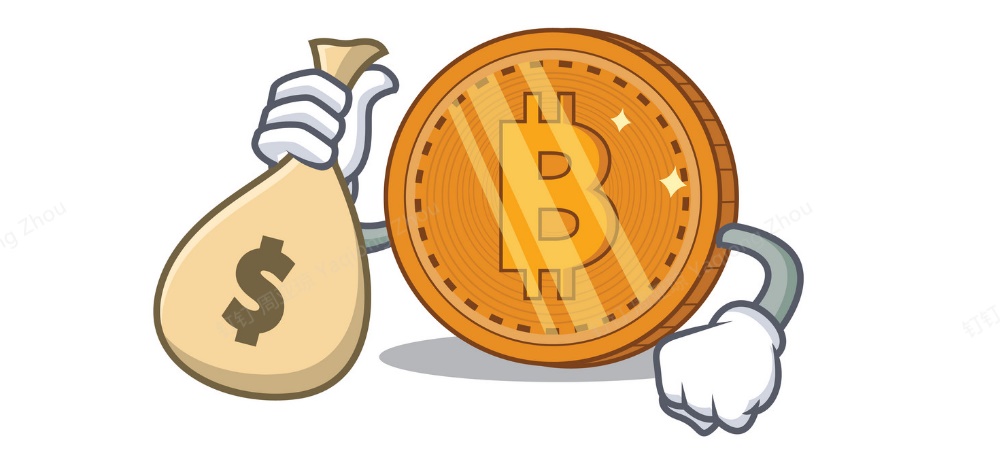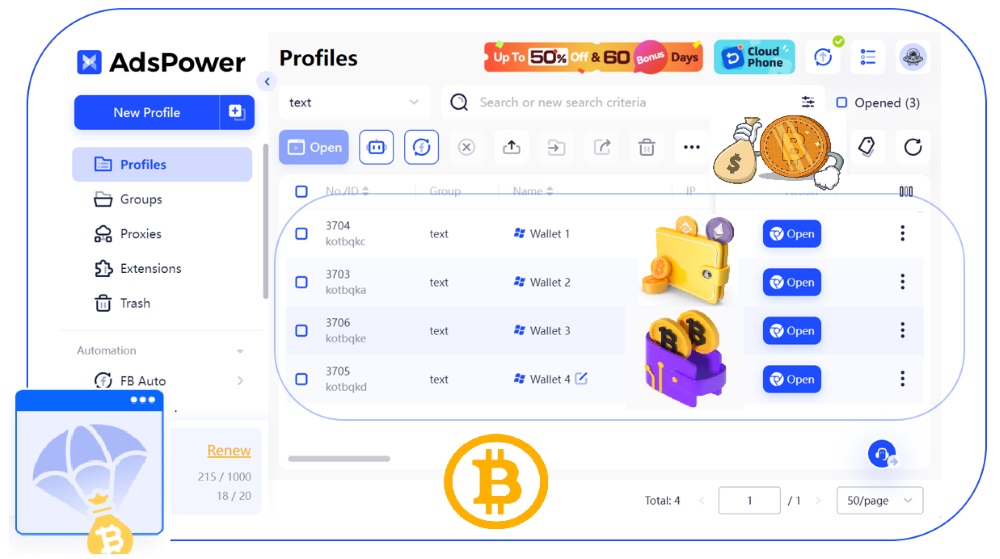How to Manage Multiple Crypto Wallets: The Ultimate Guide
Take a Quick Look
Easily manage multiple crypto wallets with less stress. Find out why you need multiple wallets, how to secure them, and the best practices for staying organized. With AdsPower, you can streamline the process and even boost your rewards.
If you're really into the world of cryptocurrency, you'll see that managing 2 or more cryptocurrency wallets is no longer optional—it's a necessity. Just like you wouldn't keep all your cash in one place, spreading your digital assets across various wallets enhances security, organization, and efficiency. Whether you're trading, saving, or interacting with dApps, effective wallet management is key to protecting your investments and unlocking their full potential.

This guide breaks down everything you need to know about managing cryptocurrency wallets, including their types, the benefits of having multiple crypto wallets, and actionable strategies for managing them effectively. Plus, we'll introduce how tools like AdsPower simplify the management of multiple wallets while enhancing your security and efficiency.
What is A Cryptocurrency Wallet?
A cryptocurrency wallet is a digital tool that allows you to store, send, and receive cryptocurrencies. Wallets hold the private keys needed to access your digital assets on the blockchain, making them a vital part of crypto management. While wallets don't store actual cryptocurrencies (these remain on the blockchain), they act as gateways to your funds.
Main Types of Cryptocurrency Wallets and Their Pros and Cons
|
Wallet Type |
Description |
Advantages |
Disadvantages |
Examples |
|
Hot Wallet |
Connected to the internet; ideal for frequent transactions. |
Easy to use; instant access to funds. |
Vulnerable to hacking and phishing attacks. |
MetaMask, Phantom |
|
Cold Wallet |
Offline wallets; best for long-term storage and higher security. |
Extremely secure; not exposed to online threats. |
Less convenient for frequent transactions. |
Trezor, Ledger |
|
Desktop Wallet |
Software installed on computers; balances usability and security. |
User-controlled; accessible without the internet. |
Susceptible to malware and system crashes. |
Exodus, Atomic Wallet |
|
Mobile Wallet |
Apps for smartphones; convenient for on-the-go transactions. |
Portable; supports QR code transactions. |
Risk of theft or loss with the device. |
Trust Wallet, Coinbase |
|
Paper Wallet |
Printed keys or QR codes; offers offline storage but is less user-friendly. |
Immune to online attacks. |
Fragile; easily damaged or lost. |
Custom generated keys |
Why Should You Have Multiple Crypto Wallets?
Why should you consider managing several crypto wallets instead of just one? Having more than one wallet offers numerous strategic advantages. Let's explore the benefits of maintaining multiple cryptocurrency wallets:
Enhanced Security
By distributing your assets across 2 or more wallets wallets, you can minimize the risk of losing all your funds in the event of a security breach. This strategy is akin to not keeping all your eggs in one basket. If one wallet is compromised, the others may remain secure, thus safeguarding a portion of your assets. For example, consider using one wallet exclusively for high-value, long-term holdings and another for daily trading activities. If the trading wallet is compromised, your long-term investments remain secure and untouched.
Portfolio Diversification
Diversification isn't just for investments—your wallets should also reflect this strategy. Storing different cryptocurrencies in dedicated wallets reduces the impact of potential losses tied to one wallet or currency. For example, you could keep Bitcoin in a hardware wallet for security, Ethereum in a software wallet for convenience, and smaller altcoins in a hot wallet for frequent trades.
Organization and Financial Clarity
Separating assets by purpose improves financial management. With distinct wallets for savings, trading, and decentralized app (dApp) interactions, tracking your transactions becomes more straightforward. This organization helps avoid confusion, especially during tax season or when reviewing your portfolio's performance. For example: A dApp wallet for DeFi activities might see dozens of transactions daily. By isolating it from your savings wallet, you maintain clear records and avoid clutter.
Backup and Accessibility
If one wallet becomes inaccessible—for instance, due to technical issues or loss of access credentials—you still have access to your funds in other wallets. This redundancy ensures you won't lose all your digital assets because of a single failure.
How to Manage Multiple Crypto Wallets? Best Practices

Managing multiple cryptocurrency wallets effectively requires a strategic approach to both security and organization. Here's an ultimate guide to help you navigate the complexities of handling multiple wallets:
1. Choose the Right Wallets
-
Diversity in Wallet Types: Use a combination of hot wallets (online) for daily transactions and cold wallets (offline) for long-term storage to balance convenience and security.
-
Reputable Providers: Opt for wallets from reputable providers to ensure reliability and robust security features.
2. Secure Your Wallets
-
Strong, Unique Passwords: Each wallet should have a unique, strong password. Consider using a password manager to keep track of them.
-
Two-Factor Authentication (2FA): Enable 2FA on all wallets that support it to add an extra layer of security.
-
Regular Updates: Keep your wallet software updated to protect against new vulnerabilities.
-
Use Secure Devices: Avoid accessing wallets on shared or public devices.
3. Organize Your Assets
-
Purpose-Based Distribution: Allocate different wallets for specific purposes—e.g., trading, savings, everyday spending.
-
Label and Document: Clearly label each wallet and keep detailed records of what each is used for, including the addresses and key transactions.
4. Regular Monitoring and Audits
-
Check Balances Regularly: Regularly review the balances and transactions of each wallet to detect any unauthorized activity early.
-
Perform Security Audits: Periodically review your security practices and wallet setups to ensure they are still effective.
5. Backup and Recovery
-
Secure Backups: Make encrypted backups of wallet data, and store them in multiple secure locations.
-
Recovery Plans: Ensure you have a clear and tested plan for recovering your wallets in case of device failure or loss.
6. Stay Informed
-
Educate Yourself: Stay updated on the latest in crypto security and wallet management practices.
-
Watch for Phishing: Be vigilant about phishing attempts and suspicious links, especially those purporting to be from wallet providers.
How to Secure Crypto Wallets and Avoid Hacks or Loss of Funds?
When using crypto wallets, security is one of the top concerns for users. To ensure your crypto wallets remain safe, in addition to using strong passwords, enabling two-factor authentication (2FA), and securely backing up recovery phrases, taking advantage of AdsPower can provide an extra layer of protection and even help you maximize your returns.

-
Profile Isolation: AdsPower creates isolated browser profiles for each wallet account. This ensures that activities in one account do not impact others, which is particularly valuable for preventing cross-contamination if one wallet is compromised.
-
IP Address Management: AdsPower allows users to manage and rotate IP addresses. This enhances your online anonymity and helps you bypass IP restrictions, reducing the risk of targeted attacks.

-
Maximize Airdrop Rewards: For users participating in airdrops, AdsPower can overcome claim restrictions by using multiple browser profiles with unique, realistic fingerprints that mimic real users. This allows you to collect more tokens and optimize your airdrop rewards.
Sign up today and take control of your wallets with ease!
Conclusion
Having multiple cryptocurrency wallets is not just a strategy for advanced users but a necessity for anyone looking to enhance their crypto security and organization. By following best practices and leveraging tools like AdsPower, you can simplify the complexities of multi-wallet management and focus on maximizing your crypto opportunities.
AdsPower doesn't just help you manage your wallets—it gives you the tools to do it securely, efficiently, and at scale. Ready to take your crypto management to the next level? Try AdsPower today!
FAQs
1. How Many Crypto Wallets Can a Person Have?
There's no limit to the number of crypto wallets you can have. Many users manage multiple wallets to separate funds for trading, long-term holding, and interacting with dApps, improving both security and organization.
2. What is the Best Multi-Crypto Wallet?
The best multi-crypto wallets support multiple blockchains, offer strong security features, and provide a user-friendly interface. Popular options include MetaMask, Trust Wallet, and Phantom. For a detailed comparison, check out our article: Top 10 Web3 Wallets to Secure Your Crypto and Maximize Gains in 2025.
3. Do I Need a Different Wallet for Each Cryptocurrency?
Not necessarily. Multi-chain wallets can store multiple types of cryptocurrencies under a single interface. However, for added security and clarity, some users prefer using separate wallets for specific crypto assets.
4. How to Track Multiple Crypto Wallets?
To track multiple wallets, you can use portfolio tracking tools like CoinStats, Zerion, or Blockfolio. These platforms aggregate balances and transactions across wallets, providing a comprehensive overview of your crypto holdings. For seamless multi-wallet management, consider AdsPower to streamline logins, enhance security, and manage accounts efficiently.
5. What Exchange is No KYC?
No-KYC exchanges allow you to trade crypto without identity verification, offering greater privacy. Options like Binance DEX and KuCoin are popular choices. To learn more, explore our guide: 5 Best No KYC Crypto Exchange and Why You Should Use Them.

People Also Read
- Nutra Affiliate Marketing Strategies – Expert Guide for 2025
- Simple Fixes for Common AdsPower Extension Errors and Failures
- Traffic Arbitrage for Beginners: A Step-by-Step Guide to Profitable Campaigns in 2025
- How to Bulk Update Proxies in AdsPower
- The Best Email Affiliate Marketing Strategies for Higher Conversions


